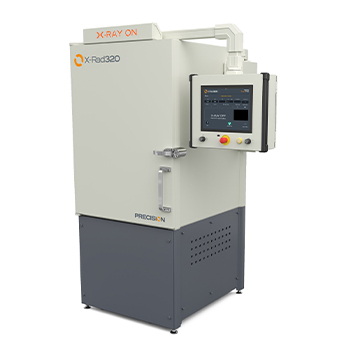Blog Standard

Exploring the role of Precision X-Ray Imaging in Cancer Biology
Introduction
DNA double – strand breaks (DSBs) are a primary mechanism that causes cancer cell death. DSBs are a result of radiation therapy given to combat cancer. This resulting damage to the DNA can however trigger a cascade of activations of DNA repair mechanism, lessening the impact of radiation therapy. This article highlights the use of Precision X-ray’s imaging systems in the delivery of siRNA through novel polymer - lipid based nanocarrier.
One of the therapeutic approaches for combating breast cancer is radiation therapy. It triggers various forms of DNA damage via the use of ionising radiation. Destruction of DNA is accompanied by DNA double–stranded breaks (DSBs), proven to be most harmful in causing cancer cell death. While radiation therapy is successful in delivering the intended DNA damage, its perverse effect is activation of DNA repair mechanisms. Cancer cells often develop resistance to this treatment by activating their DNA damage response (DDR) machinery, which repairs DSBs. RAD50, a SMC protein (Structural Maintenance of Chromosomes) along with heterotrimeric recombination 11 homolog 1 (Mre11) and Nijmegen breakage syndrome protein 1 (NBS1) form the MRN complex, which binds to damaged and broken DNA to exhibit various enzymatic activities that are crucial for the repair of DSBs.
Silencing RAD50 in cancer cells using small interfering RNA (siRNA) to enhance breast cancer chemotherapy has been explored. However, delivering siRNA to target cells and their cytoplasm poses significant obstacles, including degradation by RNAases, accumulation and penetration within tumours, cellular uptake, and entrapment and degradation within endosomes/ lysosomes. To overcome these challenges, various nanocarrier systems have been developed to improve siRNA in vivo stability, tissue bioavailability, and transfection efficiency. To help achieve the development of novel polymer–lipid based RAD50 siRNA loaded nanoparticles, Precision X-Ray systems have been employed, as highlighted in this application note.

X-RAY ON (SmART +)

X-Rad320
Experimental
MDA-MB-231 cells, a triple-negative breast cancer (TNBC) cell line, and MCF-10A cells, a non-malignant breast cell line, were acquired and cultured in Dulbecco's Modified Eagle's Medium (DMEM). The RAD50-siRNA-NPs were prepared in an oil - water emulsion. This was followed by assessment of siRNA encapsulation, in vitro transfection of RAD50 siRNA into cells and investigation of internalization and intracellular localization of siRNA-NPs. To assess the effect of RAD50-siRNA-NPs treatment and RT on DNA damage repair, MDA-MB-231 cells were treated with RAD50-siRNA-NPs or free-siRNA and then irradiated with a single dose of 5 Gy using X-RAD 320 system (Precision X-Ray, Madison, CT, USA; 320 kV, 2.7 Gy/ miFor evaluation of in vivo RAD50 silencing and biomarkers, the tumours were exposed to radiation (10 Gy) using small animal irradiator (SmART+) XRAD system (Precision X-Ray Inc., Madison, CT, USA).
Conclusion
This application highlights the use of Precision X-Ray imaging systems. The X-RAD 320 was critical in applying radiation therapy (RT) on the MDA-MB-231 cells that rendered a controlled assessment of the fate of DNA damage repair after treatment with RAD50-siRNA-NPs. Furthermore, the SmART+ XRAD system provided in vivo radiation with precision such that RAD50 silencing, and its biomarkers could be evaluated in tumour models. These results emphasize the role of Precision X-Ray imaging systems in improving our comprehension of cancer and leading to new treatments of it. The results showed that the nanoparticles successfully delivered siRNA into the cells, silenced RAD50 expression, and increased radiation-induced DNA damage. suggesting that targeting RAD50 with siRNA-NPs could be a promising strategy to improve radiation therapy outcomes for breast cancer.
Reference
1. Zetrini, A. E.; Abbasi, A. Z.; He, C.; HoYin Lip; Ibrahim Alradwan; Rauth, A. M.; Henderson, J. T.; Xiao Yu Wu. Targeting DNA Damage Repair Mechanism by Using RAD50-Silencing SiRNA Nanoparticles to Enhance Radiotherapy in Triple Negative Breast Cancer. Materials Today Bio 2024, 28, 101206–101206. DOI: 10.1016/j.mtbio.2024.101206.

